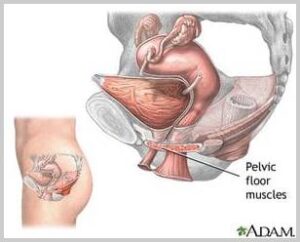Urinary Incontinence
Urinary incontinence (UI) is the loss of bladder control which results in leakage of urine. It is a common condition and be caused by many different issues. Symptoms may range in severity from occasionally leaking of urine to a sudden urge to urinate that comes on very strongly and is uncontrolled. Although it is not usually a serious condition, UI can be embarrassing and affect a person’s quality of life and day to day routine. Urinary incontinence is most common in women, especially during and after pregnancy. It can, however, affect people of all ages and both men and women. Being overweight or elderly may also increase the risk of urinary incontinence.
Causes of Urinary Incontinence
Urinary incontinence can be caused by a urinary tract infection or weak muscles in the urinary tract. There are some medications that may cause weak bladder muscles, thereby causing urinary incontinence. Weak muscles can prevent the ability to close off of the urethra, and doing certain activities may cause urine to leak such as standing, coughing or sneezing. Other causes of urinary incontinence include the following:
- Pregnancy
- Childbirth
- Menopause
- Enlarged prostate
- Prostate cancer
- Neurological disorders
- Bladder obstruction
Normal urination involves emptying the bladder when the desire to urinate occurs, and one goes to the bathroom to urinate. At this point, the bladder contracts and urine flows out of the body. Once the bladder is empty, the muscles contract and urination is completed. People with UI experience a disruption in this process that causes a loss of bladder control.
Symptoms of Urinary Incontinence
In addition to leaking urine, people with UI may also experience some of the following:
- Strong desire or urge to urinate
- Pelvic pressure
- Frequent urination
- Nocturia (the need to urinate at night while sleeping)
- Pain with urination
- Bed wetting
Types of Urinary Incontinence
Urinary incontinence is classified, based on causes and symptoms, into three different types:
Urge
Urge incontinence is the most common type of incontinence. It involves urine leakage that occurs after a sudden urge to urinate, because the muscle wall of the bladder is overactive.Patient may experience a lot of urgency to urinate.
Stress
Stress incontinence is defined as urine leakage that occurs after an activity places pressure on the bladder. Activities may include coughing, laughing or sneezing. This is most common after childbirth or in men after prostate surger.
Overflow
Overflow incontinence occurs as the result of an weak bladder muscle that does not completely empty the bladder after urination. If a bladder scan is done after urinating, they would have a lot of urine left in the bladder. This is the least common of the types of incontinence.
*Treatment for urinary incontinence varies, based on typeand severity of symptoms.
Diagnosis of Urinary Incontinence
Urinary incontinence is diagnosed through a physical examination, a series of diagnostic tests, and an evaluation of the patient’s medical and symptoms history. Patientsare likely to be asked to keep a bladder or urination diary to record the frequency and circumstances of their urination issues including timing, frequency, lifestyle factors, etc. Testing may begin with a pelvic exam to detect any physical abnormalities, and additional tests include:
- Blood tests
- Urinalysis
- Cystogram
- Urodynamics testing to evaluate bladder function
- A stress test to determine if any urine leaks during physically stressful situations
After a diagnosis of UI, the provider may perform further testing to determine the cause of the condition, in order to recommend the most appropriate treatment approach.
Treatment of Urinary Incontinence
Treatment for urinary incontinence varies, depending on the severity of the condition and the type of incontinence. There are many effective treatment options, including the following:
- Bladder training
- Avoiding alcohol and caffeine
- Medication
- Electrical stimulation (PTNS)
- BOTOX® injections
- Nerve-stimulation implant (Axonics, Interstim)
- Kegel exercises
- Pelvic floor rehab
For severe cases of UI in women, a medical device such as a urethral insert or pessary may be inserted through the vagina to prevent urine leakage. There are also artificial sphincters at times placed to help with continence. Surgery may be recommended to provide support to the bladder neck to relieve symptoms caused by UI. There are certain risks, including infection, bladder spasms and recurring incontinence, associated with surgery and therefore risks and benefits must be evaluated prior to considering and surgical intervention.
Prevention of Urinary Incontinence
Not all cases of urinary incontinence can be prevented, although the following recommendations may help in controlling urinary incontinence and decreasing the urine leakage:
- Drinking less fluid
- Emptying the bladder regularly, avoid holding urine for long periods
- Avoiding caffeinated beverages
- Avoiding trigger foods
- Kegel exercises can also help to prevent incontinence by strengthening the pelvic floor

